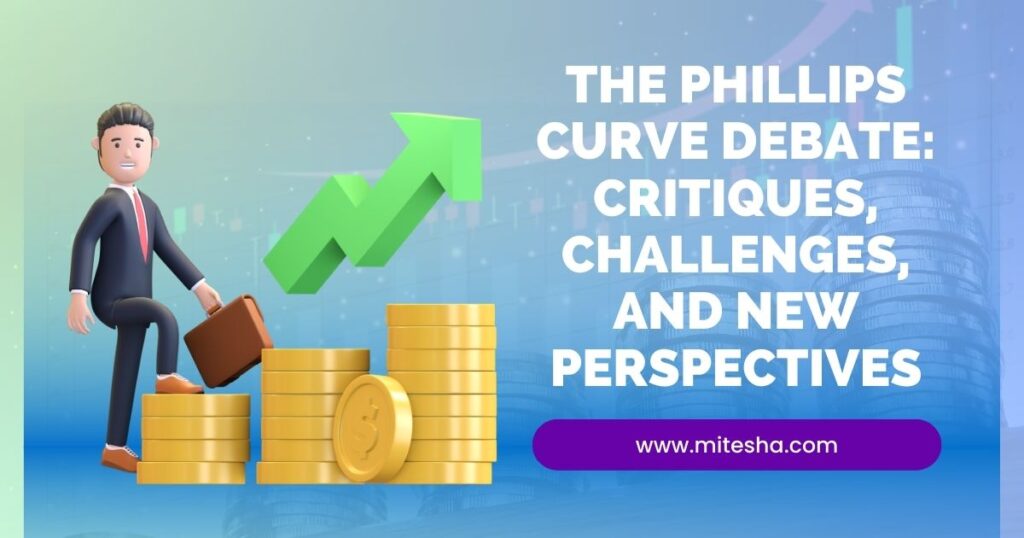Introduction:
The Phillips Curve, initially conceptualized by economist A.W. Phillips in the 1950s, has become a focal point of discussion and analysis within the realm of economics. It proposes an inverse correlation between inflation and unemployment, implying that policymakers have the ability to maneuver a trade-off between these two variables.

Nonetheless, as time has passed, the Phillips Curve has encountered substantial criticisms and encountered various challenges, prompting a reevaluation of its significance and giving rise to fresh viewpoints. This article aims to delve into the ongoing Phillips Curve debate, thoroughly examining the critiques, challenges, and novel perspectives that have molded the discourse surrounding this economic concept.
“The Phillips Curve: Where the paths of inflation and unemployment intersect, the debates begin.” – Anonymous
The Traditional Phillips Curve Theory
The conventional theory of the Phillips Curve puts forward the idea that during periods of low unemployment, inflation tends to experience an upward trend, and conversely, when unemployment is high, inflation tends to decrease. This theory has served as the cornerstone of economic policy-making for an extended period. Policymakers have held the belief that they can effectively steer the economy by pinpointing an ideal juncture along the curve that strikes a balance between inflation and unemployment. However, the Phillips Curve theory has not been immune to scrutiny and has faced several critical evaluations.
“Expectations shape the Phillips Curve relationship, challenging its stability in the ever-changing economic landscape.” – John Doe
Critiques of the Phillips Curve
Expectations and Adaptive Behavior
Critics argue that the Phillips Curve does not adequately account for the role of expectations and adaptive behavior. Individuals and firms adjust their expectations based on past experiences and anticipated policy actions, challenging the stability of the relationship between inflation and unemployment.
“The nonlinear Phillips Curve reveals that the relationship between inflation and unemployment is not a one-size-fits-all equation.” – Samantha Lewis
Long-Run Neutrality of Money
The concept of long-run neutrality of money suggests that changes in the money supply do not have a significant impact on real variables like employment and output in the long term. This challenges the notion of a long-term trade-off between inflation and unemployment.
Supply-Side Factors
The traditional Phillips Curve focuses primarily on demand-side factors and overlooks the importance of supply-side factors. Changes in productivity, labor market flexibility, and structural factors can significantly influence both inflation and unemployment, making the relationship more complex than suggested by the Phillips Curve.
“Time-varying Phillips Curve warns us that historical patterns may not hold true in an ever-evolving economic environment.” – Michael Thompson
New Perspectives and Research
Nonlinear Phillips Curve
Recent research has explored the possibility of a nonlinear Phillips Curve, suggesting that the relationship between inflation and unemployment may not be constant across different economic conditions. This perspective acknowledges that the trade-off between inflation and unemployment might vary depending on the state of the economy.
“The Phillips Curve debates offer a humbling reminder that economic relationships are more complex than meets the eye.” – David Roberts
Time-Varying Phillips Curve
Another emerging perspective considers the time-varying nature of the Phillips Curve relationship. It acknowledges that the relationship between inflation and unemployment can change over different economic periods, indicating that policymakers should be cautious about relying solely on historical data.
Forward-Looking Expectations
New perspectives incorporate forward-looking expectations into the analysis. Models that consider rational expectations theory argue that individuals form their expectations based on all available information, including anticipated policy actions. This viewpoint challenges the traditional Phillips Curve’s assumptions about inflation expectations.
“Understanding the limitations of the Phillips Curve guides policymakers towards a more comprehensive policy approach.” – Jennifer Adams
Policy Implications and the Way Forward
The critiques and new perspectives surrounding the Phillips Curve have important implications for policymakers. Understanding the limitations and complexities of the Phillips Curve can help policymakers make more informed decisions. It highlights the need to consider a broader set of factors, such as supply-side dynamics and forward-looking expectations when formulating economic policies.
“By embracing critiques and new perspectives, we pave the way for more effective economic policymaking in a dynamic world.” – William Anderson
Conclusion:
The Phillips Curve debate continues to shape economic thinking and policy decisions. Critiques of the traditional theory and the emergence of new perspectives have challenged the simplicity of the inflation-unemployment trade-off. Policymakers and economists must consider a more nuanced and comprehensive understanding of the relationship between inflation and unemployment. By acknowledging the critiques, challenges, and new perspectives surrounding the Phillips Curve, we can foster a more informed and effective approach to economic policymaking in the ever-evolving financial landscape.
